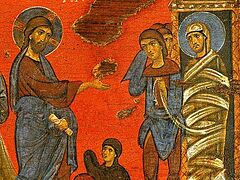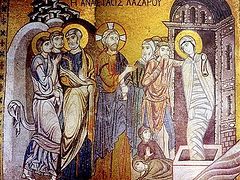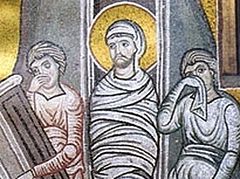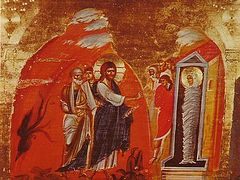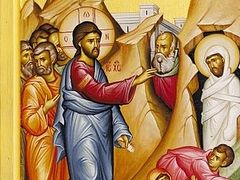Introduction
On the Saturday before Holy Week, the Orthodox Church commemorates a major feast of the year, the miracle of our Lord and Savior Jesus Christ when he raised Lazarus from the dead after he had lain in the grave four days. Here, at the end of Great Lent and the forty days of fasting and penitence, the Church combines this celebration with that of Palm Sunday. In triumph and joy the Church bears witness to the power of Christ over death and exalts Him as King before entering the most solemn week of the year, one that leads the faithful in remembrance of His suffering and death and concludes with the great and glorious Feast of Pascha.
Biblical Story
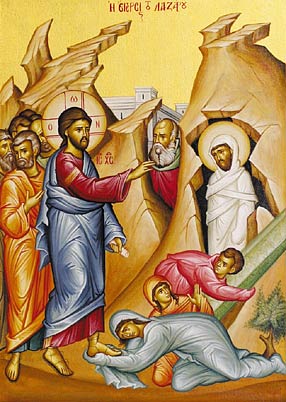 Icon of the Raising of Lazarus
Icon of the Raising of Lazarus
Jesus did not immediately go to Bethany, the town where Lazarus lived with his sisters. Instead He remained in the place where He was staying for two more days. After this time, He told his disciples that they were returning to Judea. The disciples immediately expressed their concern, stating that the Jews there had recently tried to stone Him (John 10:31). Jesus replied to His disciples, “Are there not twelve hours of daylight? Those who walk during the day do not stumble, because they see the light of this world. But those who walk at night stumble, because the light is not in them” (vv. 5-10).
After He said this, Jesus told his disciples that Lazarus had fallen asleep and that He was going there to wake him. The disciples wondered why He would go to wake Lazarus, since it was good for him to sleep if he was ill. Jesus, however, was referring to the death of Lazarus, and thus told the disciples directly that Lazarus was dead (vv. 11-14).
When Jesus arrived at Bethany, Lazarus had already been in the tomb four days. Since Bethany was near Jerusalem, many of the Jews had come to console Mary and Martha. When Martha heard that Jesus was approaching she went to meet Him and said to Him, “Lord, if you had been here, my brother would not have died. But even now I know that God will give you whatever you ask of Him.” Jesus told her that her brother will rise again. Martha said that she knew he would rise again in the resurrection on the last day. Jesus replied, “I am the resurrection and the life. Those who believe in me, even though they die, will live, and everyone who lives and believes in me will never die.” Jesus asked Martha if she believed this. She said to Him, “Yes, Lord, I believe that you are the Messiah, the Son of God, the one coming into the world” (vv. 17-27).
Martha returned to tell Mary that Jesus had come and was asking for her. Mary went to meet Him, and she was followed by those who were consoling her. The mourners followed her thinking that she was going to the tomb to weep there. When she came to Jesus, she fell at His feet and said, “Lord, if you had been here, my brother would not have died.” Jesus saw her weeping and those who were with her, and He was deeply moved. He asked to be taken to the tomb of Lazarus. As Jesus wept for Lazarus the Jews said, “See how He loved him.” Others wondered that if Jesus could open the eyes of the blind, He certainly could have kept Lazarus from dying (vv. 28-37).
Jesus came to the tomb and asked that the stone that covered the door be taken away. Martha remarked that Lazarus had now been in the tomb for four days and that there would be a stench. Jesus replied, “Did I not tell you that if you believed, you would see the glory of God?” The stone was taken away, and Jesus looked toward heaven and said, “Father, I thank you for having heard me, but I have said this for the sake of the crowd standing here, so that they may believe that you sent me.” When He had said this, He called out with a loud voice, “Lazarus, come out!” Lazarus walked out of the tomb, bound with the strips of burial cloth, and Jesus said, “Unbind him, and let him go” (vv. 38-44).
As a result of this miracle, many of the Jews that were present believed in Jesus. Others went and told the Pharisees what Jesus had done. In response the Pharisees and chief priests met and considered how they might arrest Him and put Him to death (v. 45ff).
This miracle is performed by Christ as a reassurance to His disciples before the coming Passion: they are to understand that, though He suffers and dies, yet He is Lord and Victor over death. The resurrection of Lazarus is a prophecy in the form of an action. It foreshadows Christ’s own Resurrection eight days later, and at the same time it anticipates the resurrection of all the righteous on the Last Day: Lazarus is “the saving first-fruits of the regeneration of the world.”
As the liturgical texts emphasize, the miracle at Bethany reveals the two natures of Christ the God-man. Christ asks where Lazarus is laid and weeps for him, and so He shows the fullness of His manhood, involving as it does human ignorance and genuine grief for a beloved friend. Then, disclosing the fullness of His divine power, Christ raises Lazarus from the dead, even though his corpse has already begun to decompose and stink. This double fullness of the Lord’s divinity and His humanity is to be kept in view throughout Holy Week, and above all on Good Friday. On the Cross we see a genuine human agony, both physical and mental, but we see more than this: we see not only suffering man but suffering God.
Icon of the Feast
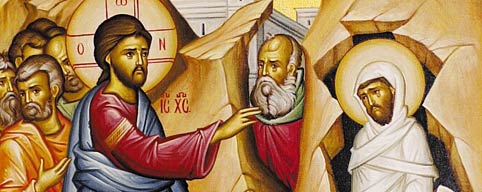
The icon of the Saturday of Lazarus shows Christ calling His friend to come out of the tomb (1). Lazarus is coming forth from the tomb (2), still bound in the strips of burial cloth. His sisters, Mary and Martha are bowing before Christ, expressing both their sorrow in the death of their brother, but also their faith in Christ as the Messiah and Son of God. Next to them is someone who has followed the request of our Lord and removed the stone from the door of the tomb (3).
|
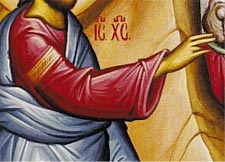 1. Christ calls his friend Lazarus to come out from his tomb.
1. Christ calls his friend Lazarus to come out from his tomb.
|
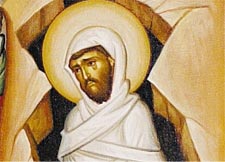 2. Lazarus is seen answering the call of his friend while still bound in his burial cloth.
2. Lazarus is seen answering the call of his friend while still bound in his burial cloth.
|
Standing with Christ are his disciples who are witnesses of this miracle, a true manifestation of the power of God that would bring them assurance during the Passion of our Lord.
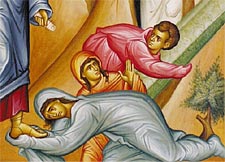 3. Mary and Martha, the sisters of Lazarus, bow before Christ as they witness this awesome miracle. A young man pulls the stone away from the front of the tomb.
3. Mary and Martha, the sisters of Lazarus, bow before Christ as they witness this awesome miracle. A young man pulls the stone away from the front of the tomb.
|
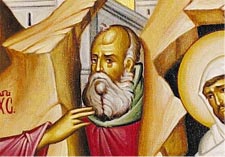 4. A man who is a part of the crowd that followed Christ, witnesses the miracle.
4. A man who is a part of the crowd that followed Christ, witnesses the miracle.
|
In the center of the icon is a person (4) who represents the crowd who also witnessed the miracle. Some believed, but others went and told the Pharisees and chief priests who continued their machinations to bring about the arrest of Christ and His death. The walled city of Jerusalem, where Christ will arrive in triumph the following day, is depicted in the background.
Orthodox christian celebration of the Saturday of Lazarus
The Saturday of Lazarus is celebrated with the Divine Liturgy of Saint John Chrysostom, which is preceded by the Matins service. On Friday before the feast, the Vespers is done either in conjunction with the Presanctified Liturgy or if this is not held, according to the order of the Triodion. The day and commemoration receives its name from the miracle of Christ recorded in the Gospel. Both this feast and Palm Sunday are joyous festivals of the Church, and thus bright colors are used for vestments and the Holy Table.
Scripture readings for the Saturday of Lazarus are: At the Orthros (Matins): No reading of the Gospel. At the Divine Liturgy: Hebrews 12:28-13:8; John 11:1-45.
At the Divine Liturgy of Lazarus Saturday, the baptismal verse from Galatians ("As many as have been baptized into Christ have put on Christ" Galatians 3:27) replaces the Thrice-Holy Hymn, thus indicating the resurrectional character of the celebration, and the fact that Lazarus Saturday was once among the few great baptismal days in the Orthodox Church Year.
Hymns of the Feast
Apolytikion: First Tone By raising Lazarus from the dead before Your Passion, You confirmed the universal resurrection, O Christ God! Like the children with palms of victory, We cry out to You, O Vanquisher of Death; Hosanna in the highest! Blessed is He that comes in the name of the Lord!
Kontakion: Second Tone Christ - the Joy, the Truth, and the Light of All, the Life of the World and the Resurrection - has appeared in his goodness to those on earth. He has become the Image of our resurrection, granting divine forgiveness to all.
Troparion of Saturday of St. Lazarus, Orthros. Tone 1
O Christ God, when Thou didst raise Lazarus from the dead, before Thy Passion, thou didst confirm the universal resurrection. Wherefore, we, like babes, carry the insignia of triumph and victory, and cry to Thee, O vanquisher of death, Hosanna in the highest. Blessed is he that cometh in the Name of the Lord. Listen »
Exaposteilaria, Saturday of St. Lazarus. Tone 3
By Your word, O Word of God, Lazarus now leaps out of death, having returned to this life. Therefore the peoples honor You with their branches, O Mighty One; for You shall destroy Hades utterly by Your own death.
By means of Lazarus has Christ already plundered you, O death. Where is your victory, O Hades? For the lament of Bethany is handed over now to you. Let us all wave against it our branches of victory. Listen »

